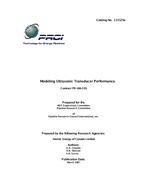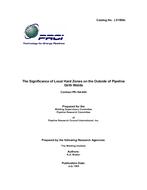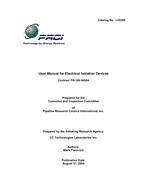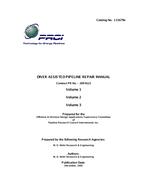Provide PDF Format
PRCI PR-166-519
- Modeling Ultrasonic Transducer Performance
- Report / Survey by Pipeline Research Council International, 03/01/1987
- Publisher: PRCI
$98.00$195.00
L51523e
Atomic Energy of Canada Ltd. Research Company
Need: Although automated ultrasonic inspection systems show considerable promise for pipeline weld inspection, they are used infrequently because difficulties with sensitivity, weld zone coverage, and the discrimination of imperfections from weld features lead to missed defects and false calls (mistaking weld geometry for defects). The present standards for pipeline construction require radiography for detection of girth weld defects. Radiography has inherent limitations for detection and sizing of serious planar defects; therefore, attention is turning to ultrasonic testing, which has advantages for detecting and sizing these defects.
Result: The ultimate objective of this work is to produce guidelines for the design of ultrasonic procedures that reliably and efficiently detect serious defects in pipeline girth welds without producing false calls. This is the final report for a contract which assesses the ability of EWE, an existing AECL computer model, to accurately simulate ultrasonic response from defects typically found in pipeline girth welds by modeling situations commonly found in pipelines and comparing modeled results with equivalent laboratory experiments. The main goal of this contract is to determine if EWE can help improve the accuracy and reliability of ultrasonic testing of pipeline girth welds by answering the following questions:
i) Are numerical A-scans in pulse echo mode accurate predictions of experimental A-scans?
ii) Are scattered waves predicted by EWE confirmed experimentally?
iii) Is EWE a useful tool for designing effective ultrasonic procedures?
Benefit: Comparison of numerical and experimental A-scans confirmed that EWE could accurately predict the number of signals, their relative size, and the time difference between them. The comparison also confirmed EWE can predict how the amplitude of the main signal in a pulse echo A-scan changes as the defect size changes and as the probe is moved closer to or further from the defect. Since EWE produces accurate A-scans, it can be used to develop and test ultrasonic inspection techniques. For example, the ultrasonic response from different sized defects can be simulated to determine the defect size that passes a particular inspection procedure. Also, the change in the A-scan as the probe is moved can help characterize a particular type of defect.
EWE is important for these applications because it provides a repeatable, controlled, and perfectly understood environment for testing. EWE also proved it can predict the type and placement of a probe to measure a particular wave scattered from a defect. This makes EWE an important tool for developing new types of inspection techniques that use multiple probes. These tests highlighted that the interaction of an ultrasonic wave with a defect is very complicated and traditional methods for understanding this interaction are inadequate. Solution of the fundamental equations provides visualization of the ultrasonic waves, understanding of inspection results, and a tool for developing efficient reliable inspection techniques.
Atomic Energy of Canada Ltd. Research Company
Need: Although automated ultrasonic inspection systems show considerable promise for pipeline weld inspection, they are used infrequently because difficulties with sensitivity, weld zone coverage, and the discrimination of imperfections from weld features lead to missed defects and false calls (mistaking weld geometry for defects). The present standards for pipeline construction require radiography for detection of girth weld defects. Radiography has inherent limitations for detection and sizing of serious planar defects; therefore, attention is turning to ultrasonic testing, which has advantages for detecting and sizing these defects.
Result: The ultimate objective of this work is to produce guidelines for the design of ultrasonic procedures that reliably and efficiently detect serious defects in pipeline girth welds without producing false calls. This is the final report for a contract which assesses the ability of EWE, an existing AECL computer model, to accurately simulate ultrasonic response from defects typically found in pipeline girth welds by modeling situations commonly found in pipelines and comparing modeled results with equivalent laboratory experiments. The main goal of this contract is to determine if EWE can help improve the accuracy and reliability of ultrasonic testing of pipeline girth welds by answering the following questions:
i) Are numerical A-scans in pulse echo mode accurate predictions of experimental A-scans?
ii) Are scattered waves predicted by EWE confirmed experimentally?
iii) Is EWE a useful tool for designing effective ultrasonic procedures?
Benefit: Comparison of numerical and experimental A-scans confirmed that EWE could accurately predict the number of signals, their relative size, and the time difference between them. The comparison also confirmed EWE can predict how the amplitude of the main signal in a pulse echo A-scan changes as the defect size changes and as the probe is moved closer to or further from the defect. Since EWE produces accurate A-scans, it can be used to develop and test ultrasonic inspection techniques. For example, the ultrasonic response from different sized defects can be simulated to determine the defect size that passes a particular inspection procedure. Also, the change in the A-scan as the probe is moved can help characterize a particular type of defect.
EWE is important for these applications because it provides a repeatable, controlled, and perfectly understood environment for testing. EWE also proved it can predict the type and placement of a probe to measure a particular wave scattered from a defect. This makes EWE an important tool for developing new types of inspection techniques that use multiple probes. These tests highlighted that the interaction of an ultrasonic wave with a defect is very complicated and traditional methods for understanding this interaction are inadequate. Solution of the fundamental equations provides visualization of the ultrasonic waves, understanding of inspection results, and a tool for developing efficient reliable inspection techniques.





